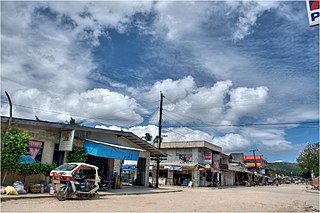
Coron, officially the Municipality of Coron, is a 1st class municipality in the province of Palawan, Philippines. According to the 2020 census, it has a population of 65,855 people.

Aborlan, officially the Municipality of Aborlan, is a 1st class municipality in the province of Palawan, Philippines. According to the 2020 census, it has a population of 38,736 people.

Brooke's Point, officially the Municipality of Brooke's Point, is a 1st class municipality in the province of Palawan, Philippines. According to the 2020 census, it has a population of 73,994 people.

Sofronio Española, officially the Municipality of Sofronio Española, is a 2nd class municipality in the province of Palawan, Philippines. According to the 2020 census, it has a population of 37,416 people.

Culion, officially the Municipality of Culion, is a 3rd class municipality in the province of Palawan, Philippines. According to the 2020 census, it has a population of 23,213 people.

Lubang, officially the Municipality of Lubang, is a 4th class municipality in the province of Occidental Mindoro, Philippines. According to the 2020 census, it has a population of 17,437 people.

Araceli, officially the Municipality of Araceli, is a 4th class municipality in the province of Palawan, Philippines. According to the 2020 census, it has a population of 14,434 people.

Balabac, officially the Municipality of Balabac, is a 2nd class municipality in the province of Palawan, Philippines. According to the 2020 census, it has a population of 42,527 people.

Cagayancillo, officially the Municipality of Cagayancillo, is a 6th class municipality in the province of Palawan, Philippines. According to the 2020 census, it has a population of 6,884 people.

Cuyo, officially the Municipality of Cuyo, is a 4th class municipality in the province of Palawan, Philippines. According to the 2020 census, it has a population of 23,489 people.

Dumaran, officially the Municipality of Dumaran, is a 3rd class municipality in the province of Palawan, Philippines. According to the 2020 census, it has a population of 23,528 people.

Magsaysay, officially the Municipality of Magsaysay, is a 5th class municipality in the province of Palawan, Philippines. According to the 2020 census, it has a population of 12,603 people.

Narra, officially the Municipality of Narra, is a 1st class municipality in the province of Palawan, Philippines. According to the 2020 census, it has a population of 77,948 people.

Linapacan, officially the Municipality of Linapacan, is a 5th class municipality in the province of Palawan, Philippines. According to the 2020 census, it has a population of 16,424 people.

Quezon, named by the late President Manuel L. Quezon and officially named the Municipality of Quezon, is a first-class municipality in the province of Palawan, Philippines. According to the 2020 census, it has a population of 65,283 people.

Rizal, officially the Municipality of Jose P. Rizal,, is a 1st class municipality in the province of Palawan, Philippines. According to the 2020 census, it has a population of 56,162 people.

Roxas, officially the Municipality of Roxas, is a 1st class municipality in the province of Palawan, Philippines. According to the 2020 census, it has a population of 69,624 people.

San Vicente, officially the Municipality of San Vicente, is a 1st class municipality in the province of Palawan, Philippines. According to the 2020 census, it has a population of 33,507 people.

Taytay, officially the Municipality of Taytay, is a 1st class municipality in the province of Palawan, Philippines. According to the 2020 census, it has a population of 83,357 people.
The Agutaynen language is spoken on Agutaya Island in the province of Palawan in the Philippines.


























